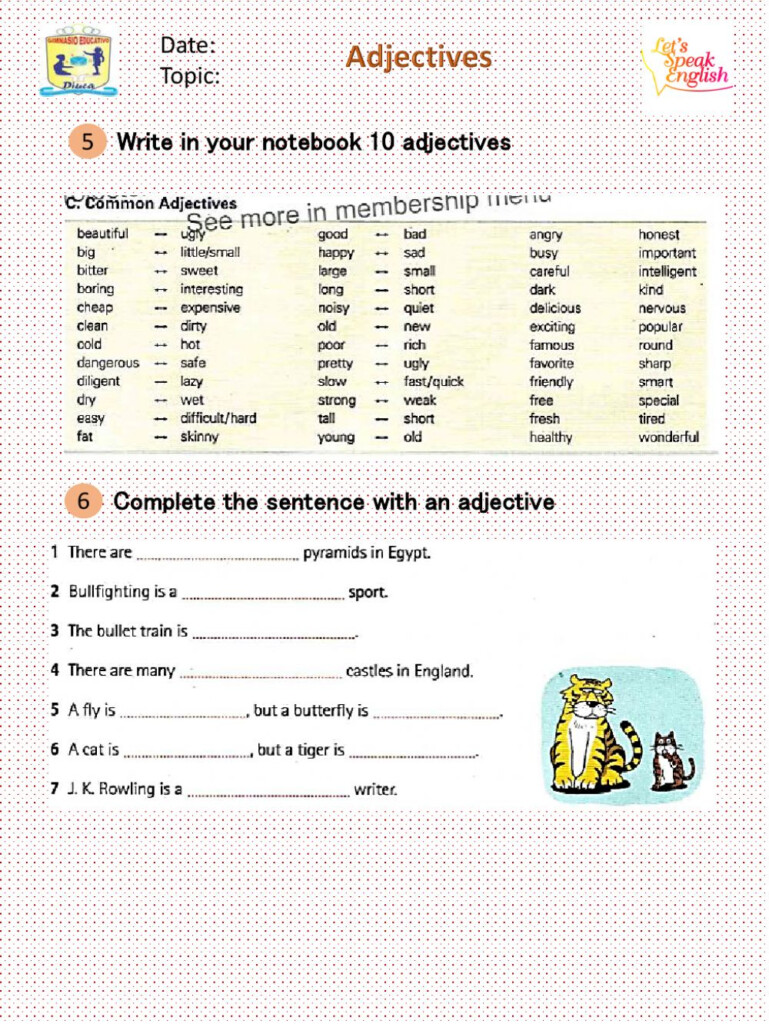
Mastering Descriptive Language: A Deep Dive into Adjectives Worksheets for Grade 5
Language is the paintbrush of thought, and adjectives are the vibrant colors that bring our thoughts to life. For fifth-grade students, mastering adjectives is not just about identifying words that describe nouns; it’s about unlocking the power of vivid communication, enhancing their writing, and developing a deeper appreciation for the nuances of the English language. This comprehensive article will explore the critical role of adjectives, why Grade 5 is a pivotal stage for their mastery, and how well-designed adjectives worksheets for Grade 5 can serve as an indispensable tool in this journey.
The Power of Adjectives: Beyond Simple Description
Adjectives are words that modify or describe nouns and pronouns. They answer questions like "Which one?", "What kind?", or "How many?". While seemingly straightforward, their impact on communication is profound. Consider the difference between "a house" and "a dilapidated, haunted, ancient house." The adjectives transform a simple noun into a detailed image, evoking emotions and painting a clear picture in the reader’s mind.
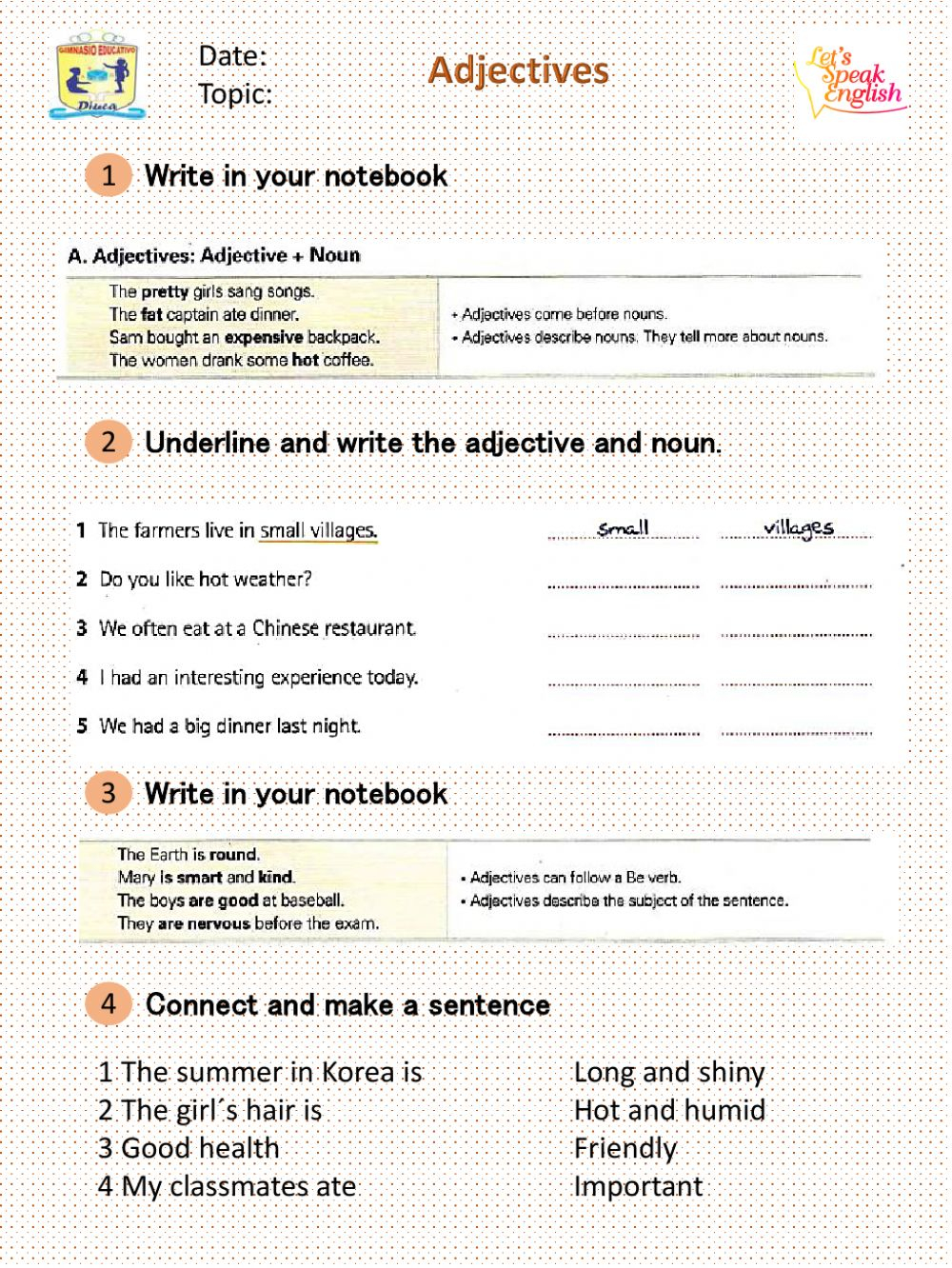
For a fifth grader, understanding adjectives moves them beyond basic sentence construction into the realm of expressive and persuasive writing. They learn to:

- Create vivid imagery: Describing characters, settings, and objects with precision.
- Enhance clarity: Distinguishing between similar items (e.g., "the red ball" vs. "the blue ball").
- Convey emotions and tone: A "joyful laugh" differs significantly from a "nervous giggle."
- Improve comprehension: Better understanding of descriptive texts in reading.
- Develop critical thinking: Choosing the best adjective for a particular context.
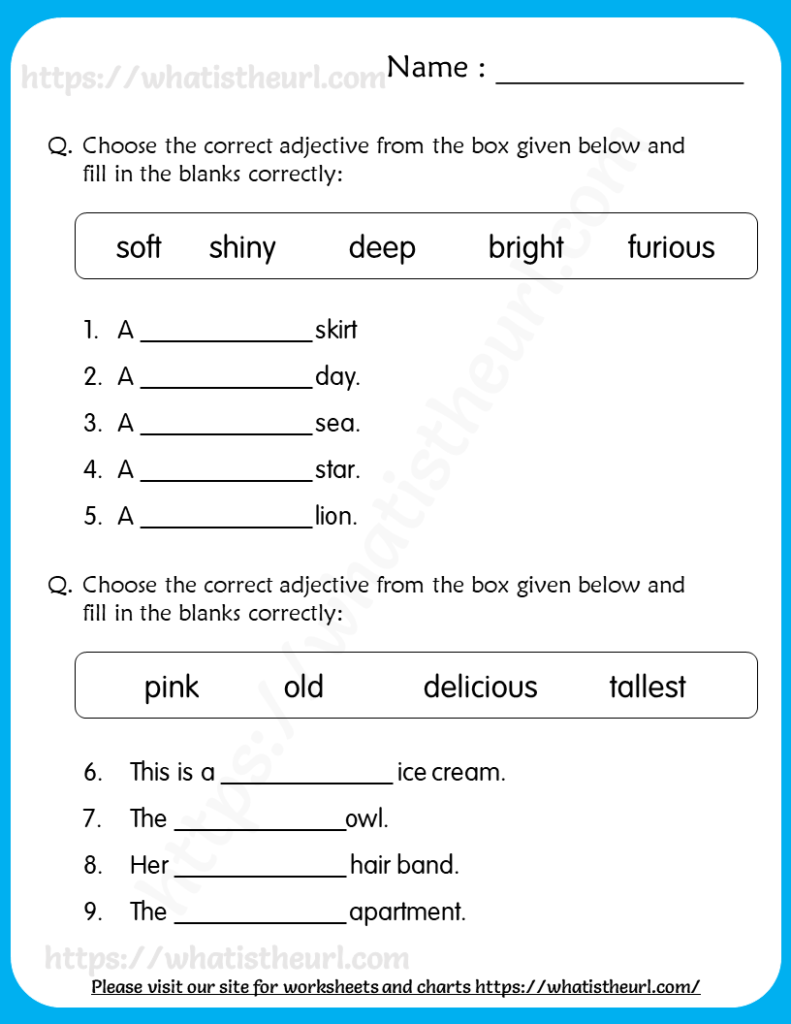


Grade 5: A Pivotal Stage for Adjective Mastery
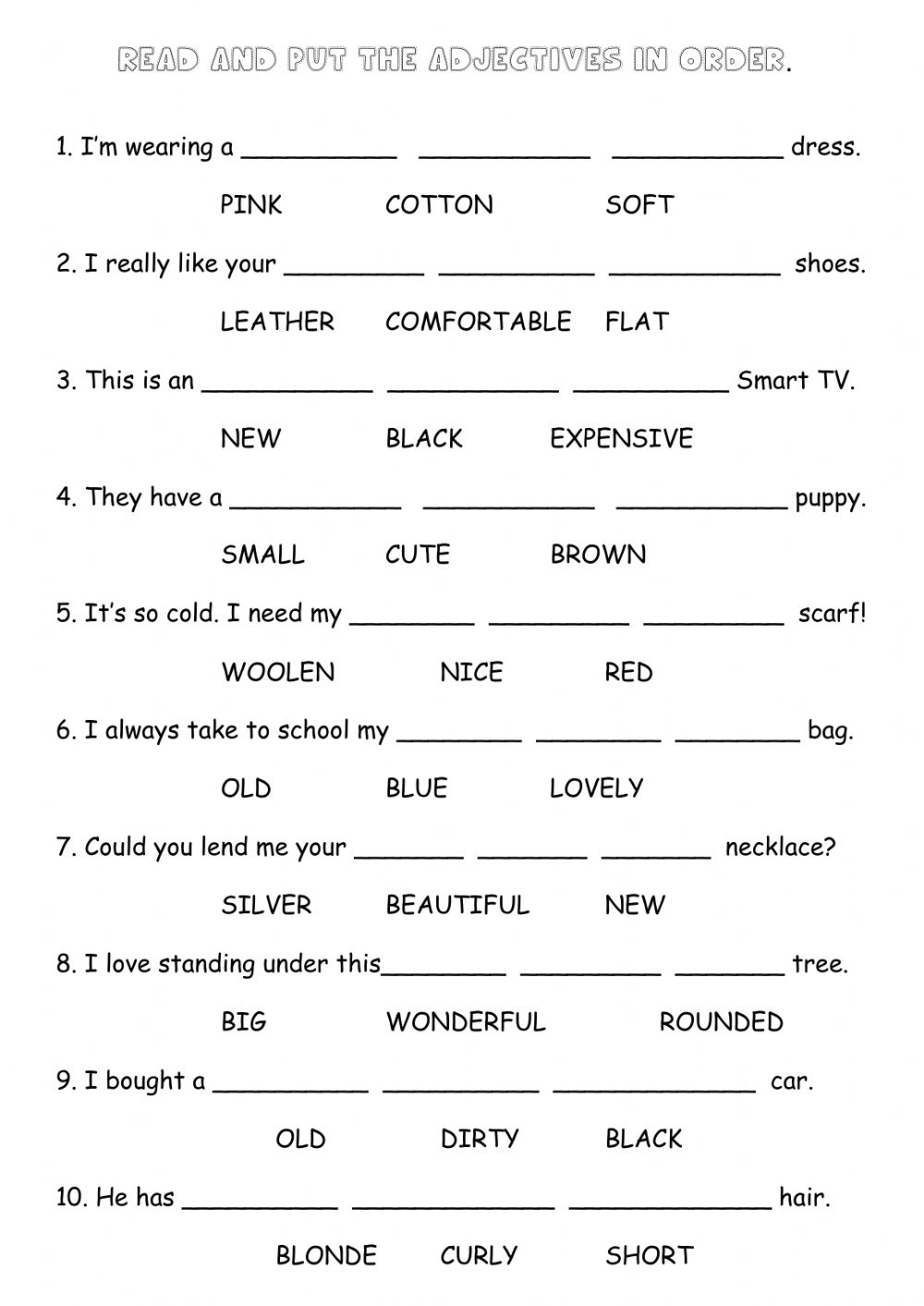
By Grade 5, students have typically moved beyond basic noun and verb identification. They are ready to delve deeper into the complexities of sentence structure and word function. This stage is crucial for several reasons:
- Transition to Complex Writing: Fifth graders are expected to write more elaborate narratives, descriptive essays, and informational reports. A strong grasp of adjectives is fundamental to achieving this.
- Understanding Comparative and Superlative Forms: This is often a key learning objective in Grade 5. Students learn to compare two items (e.g., "taller," "more beautiful") and three or more items (e.g., "tallest," "most beautiful"). They also encounter irregular forms like "good, better, best" or "bad, worse, worst."
- Predicate Adjectives: Identifying adjectives that follow a linking verb and describe the subject (e.g., "The sky is blue").
- Proper Adjectives: Understanding how proper nouns can be transformed into adjectives (e.g., "American history," "Shakespearean play").
- Ordering Adjectives: Learning that adjectives often follow a specific order when multiple adjectives modify a single noun (e.g., "a big, old, red car" not "a red, old, big car"). This concept, while subtle, significantly impacts fluency and natural language use.
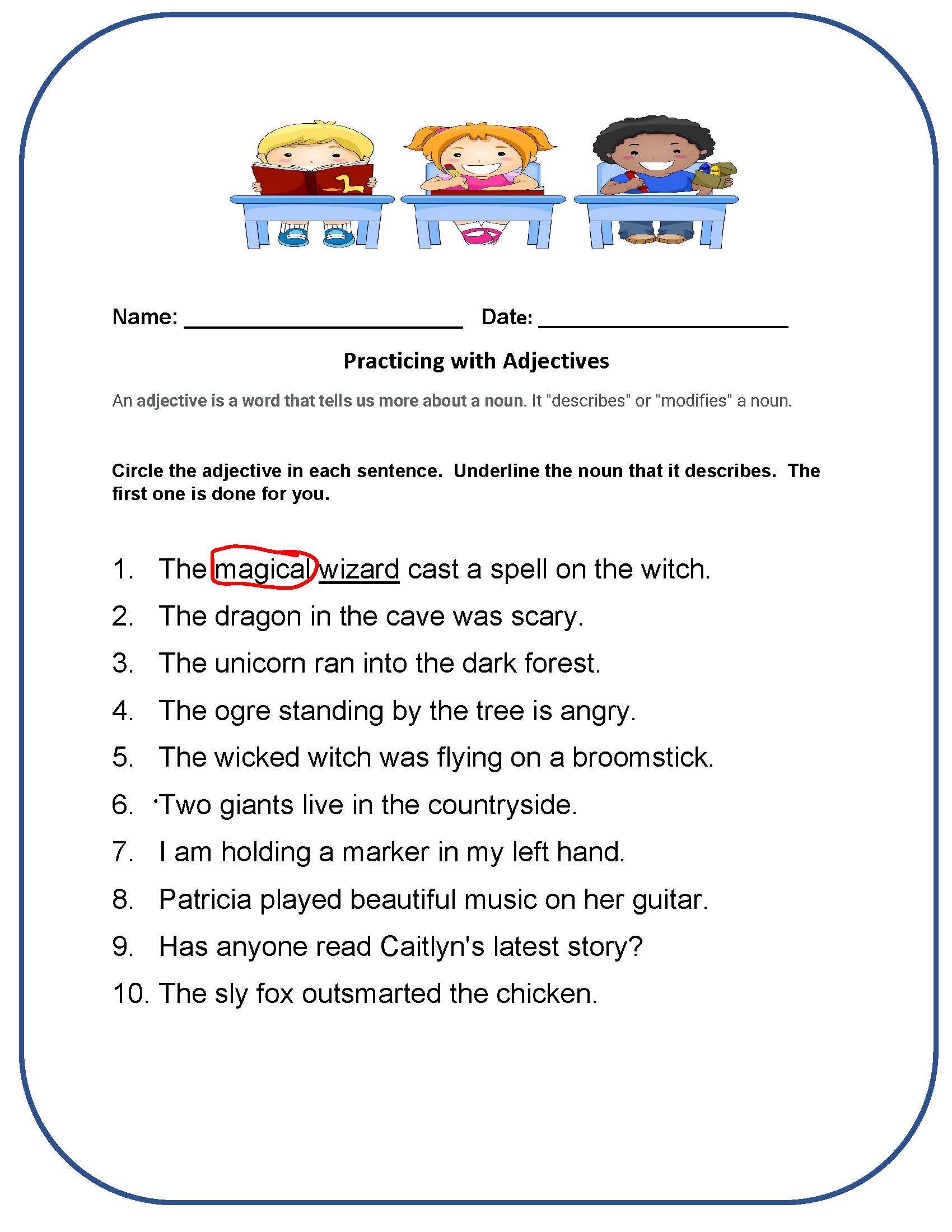
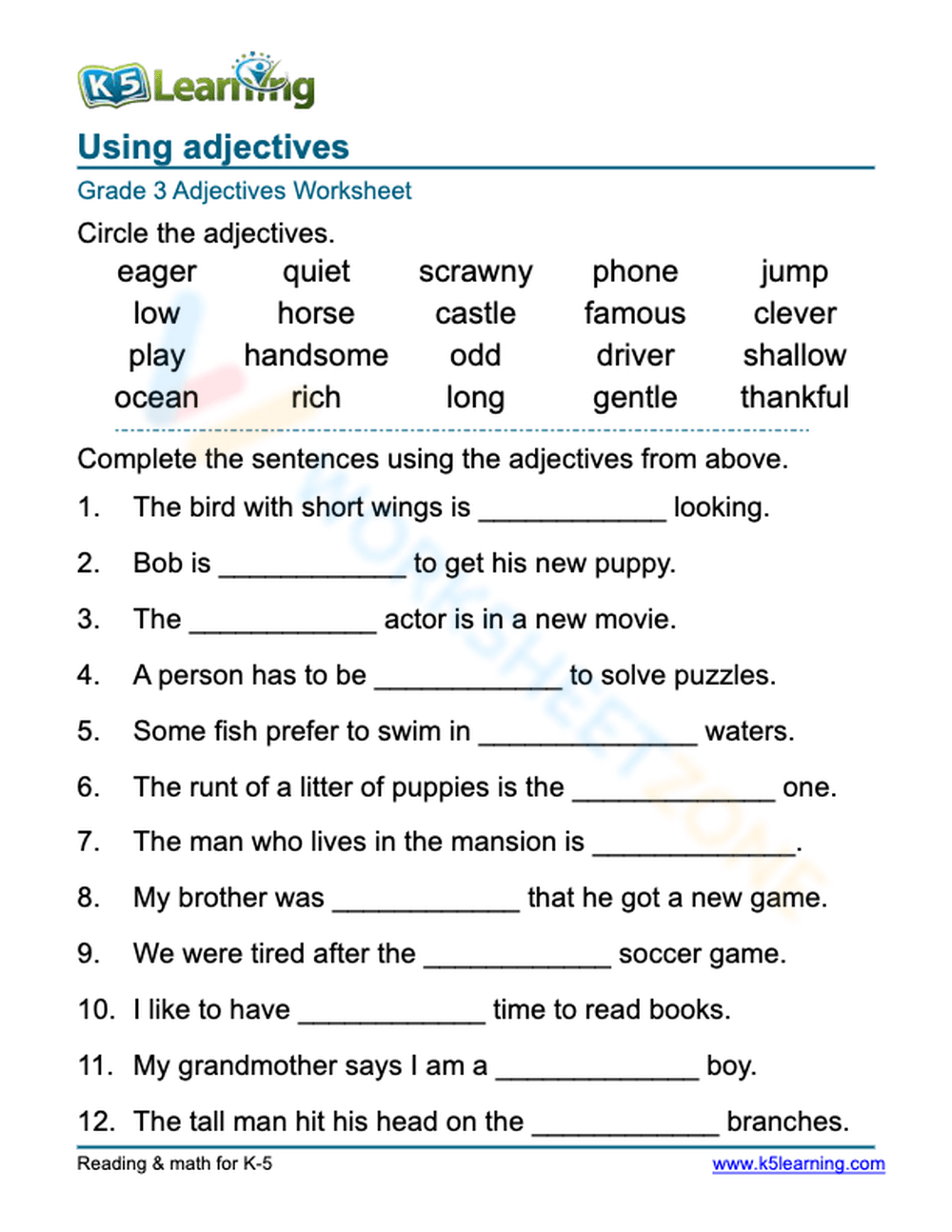
Given these advanced concepts, structured practice is essential. This is where well-designed adjectives worksheets for Grade 5 come into play.
The Indispensable Role of Adjectives Worksheets for Grade 5
Worksheets provide a structured, repetitive, and targeted approach to learning grammar concepts. For adjectives, they offer an invaluable platform for practice and reinforcement. Here’s why they are so effective:
- Targeted Practice: Worksheets can focus on specific adjective concepts (e.g., only comparative forms, or only identifying adjectives in sentences), allowing students to hone in on areas where they need improvement.
- Reinforcement of Concepts: Repeated exposure to different types of exercises helps solidify understanding and retention.
- Self-Assessment and Immediate Feedback: Many worksheets come with answer keys, allowing students to check their work independently and understand where they made mistakes. This fosters autonomy in learning.
- Variety of Exercises: From simple identification to creative writing prompts, worksheets can offer diverse activities that cater to different learning styles.
- Differentiated Instruction: Teachers can select or create worksheets that match the varying skill levels within their classroom, providing support for struggling learners and challenges for advanced ones.
- Progress Tracking: Completed worksheets can serve as a record of a student’s progress over time, highlighting areas of mastery and areas that still require attention.
Types of Adjectives Worksheets for Grade 5: A Comprehensive Toolkit
To truly master adjectives, students need exposure to a wide array of exercise types. Here’s a breakdown of effective adjectives worksheets for Grade 5 that educators and parents can utilize:
1. Adjective Identification Worksheets
- Concept: Basic recognition of adjectives.
- Activities:
- Underline the Adjectives: Students read sentences and underline all the adjectives.
- Example: The fluffy cat chased the small mouse.
- Circle the Adjectives: Similar to underlining, but perhaps with a word bank where students circle the adjectives.
- Color-Coding: Assigning different colors for adjectives, nouns, and verbs in sentences to visually differentiate parts of speech.
- Underline the Adjectives: Students read sentences and underline all the adjectives.
2. Adjective Usage and Placement Worksheets
- Concept: Understanding where adjectives typically appear in a sentence.
- Activities:
- Fill-in-the-Blanks: Provide sentences with blanks and a word bank of adjectives for students to choose from.
- Example: The dog barked at the squirrel. (Options: happy, tiny)
- Sentence Expansion: Give a basic sentence and ask students to add adjectives to make it more descriptive.
- Example: The boy ran. -> The energetic boy ran quickly. (Note: "quickly" is an adverb, good for later differentiation). A better example: The boy ate the apple. -> The hungry boy ate the crisp, red apple.
- Ordering Adjectives: Provide a noun and several adjectives, asking students to arrange them in the correct order.
- Example: car / old / big / red -> A big, old, red car.
- Fill-in-the-Blanks: Provide sentences with blanks and a word bank of adjectives for students to choose from.
3. Comparative and Superlative Adjectives Worksheets
- Concept: Forming and using adjectives to compare two or more items.
- Activities:
- Transformation Tables: A table with a positive adjective, a column for its comparative form, and a column for its superlative form.
- Example: tall | taller | tallest
- good | better | best
- Sentence Completion: Students complete sentences using the correct comparative or superlative form.
- Example: My dog is (fast) ___ than your dog. (faster)
- Mount Everest is the (high) ___ mountain in the world. (highest)
- Choose the Correct Form: Multiple-choice questions asking students to select the appropriate comparative/superlative.
- Transformation Tables: A table with a positive adjective, a column for its comparative form, and a column for its superlative form.
4. Predicate Adjectives Worksheets
- Concept: Identifying adjectives that describe the subject but come after a linking verb (is, am, are, was, were, seems, feels, tastes, etc.).
- Activities:
- Identify Linking Verb and Predicate Adjective: Students underline the linking verb and circle the predicate adjective in sentences.
- Example: The soup tastes delicious.
- Complete the Sentence with a Predicate Adjective: Provide sentences with linking verbs and ask students to add an appropriate predicate adjective.
- Example: The sky looked ___. (blue, stormy, clear)
- Identify Linking Verb and Predicate Adjective: Students underline the linking verb and circle the predicate adjective in sentences.
5. Proper Adjectives Worksheets
- Concept: Understanding adjectives derived from proper nouns and their capitalization.
- Activities:
- Convert Proper Nouns to Adjectives: Give a list of countries, continents, or famous names and ask students to write the corresponding proper adjective.
- Example: America -> American; China -> Chinese; Shakespeare -> Shakespearean.
- Use Proper Adjectives in Sentences: Students write sentences using given proper adjectives.
- Convert Proper Nouns to Adjectives: Give a list of countries, continents, or famous names and ask students to write the corresponding proper adjective.
6. Adjectives vs. Adverbs Worksheets
- Concept: Differentiating between words that describe nouns (adjectives) and words that describe verbs, adjectives, or other adverbs (adverbs). This is crucial for Grade 5 as students start encountering adverbs more frequently.
- Activities:
- Sort the Words: Provide a list of words and ask students to sort them into "Adjective" and "Adverb" categories.
- Identify Adjectives and Adverbs in Sentences: Students underline adjectives and circle adverbs.
- Example: The quick fox ran quickly across the green field.
- Choose the Correct Word: Sentences with a blank and two options (one adjective, one adverb) for students to choose from.
- Example: She sings (good/well). -> She sings well. (This highlights the common mistake of using "good" as an adverb). A better example for direct adjective/adverb choice: He is a (slow/slowly) runner. -> He is a slow runner.
7. Creative Writing and Application Worksheets
- Concept: Applying adjective knowledge in their own writing.
- Activities:
- Describe a Picture: Students are given a picture and asked to write sentences or a paragraph describing it using at least five adjectives.
- Character/Setting Description: Prompts asking students to describe a fictional character or setting using a specified number of adjectives.
- Sensory Details: Worksheets that encourage students to use adjectives appealing to the five senses (e.g., "What does a rainy day look like? smell like? feel like?").
Designing and Utilizing Effective Adjectives Worksheets for Grade 5
For worksheets to be truly effective, their design and implementation are key:
- Clear Instructions: Ensure students understand exactly what is expected of them.
- Engaging Content: Use themes, characters, or scenarios that resonate with fifth graders to keep them interested.
- Gradual Difficulty: Start with simpler tasks and progressively introduce more complex concepts.
- Visual Appeal: Use clear fonts, appropriate spacing, and occasional relevant illustrations to make the worksheets less intimidating and more inviting.
- Provide Examples: Always include one or two completed examples for each new type of exercise.
- Integrate with Other Activities: Worksheets should not be the sole method of instruction. Combine them with interactive games, group discussions, reading descriptive texts, and actual writing assignments.
- Feedback, Not Just Grades: When reviewing worksheets, provide constructive feedback beyond just marking right or wrong. Explain why an answer is incorrect and guide them to the right understanding.
- Encourage Self-Correction: Instead of immediately giving the answer, ask students to re-examine their work and identify their own errors.
Challenges and Solutions
While adjectives worksheets for Grade 5 are highly beneficial, some challenges may arise:
- Boredom/Monotony: Students might get tired of repetitive exercises.
- Solution: Vary the types of worksheets, incorporate gamification (e.g., timed challenges, team competitions), and connect worksheet content to real-world applications or fun stories.
- Difficulty with Abstract Concepts: Some students may struggle with the abstract nature of grammar rules.
- Solution: Use concrete examples, visual aids, and connect adjectives to their sensory experiences. Role-playing or drawing can also help.
- Over-reliance on Worksheets: Some educators might rely too heavily on worksheets, neglecting other forms of instruction.
- Solution: Balance worksheet practice with interactive lessons, reading aloud, creative writing, and oral language activities where students naturally use descriptive language.
Conclusion
Mastering adjectives is a cornerstone of effective communication and strong writing skills for fifth-grade students. Well-designed and strategically utilized adjectives worksheets for Grade 5 are an invaluable resource in this learning journey. By providing targeted practice, reinforcing key concepts, and offering a variety of engaging activities, these worksheets empower students to confidently wield the power of descriptive language. They transform the abstract rules of grammar into tangible, manageable tasks, helping young learners not just identify adjectives, but truly appreciate their vibrant contribution to the richness and clarity of the English language. As students progress, their command over adjectives will serve them well, enabling them to express themselves with precision, creativity, and impact in all their future academic and personal endeavors.

